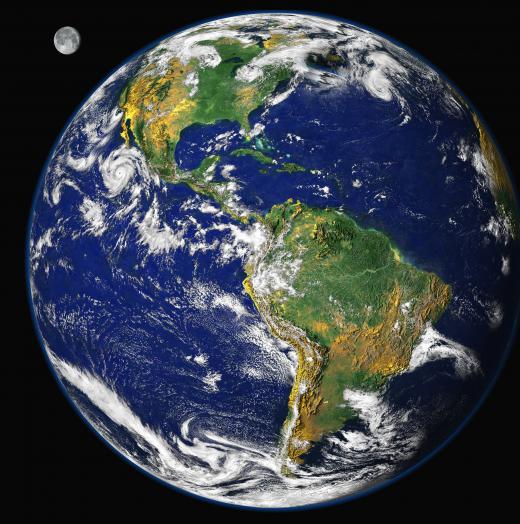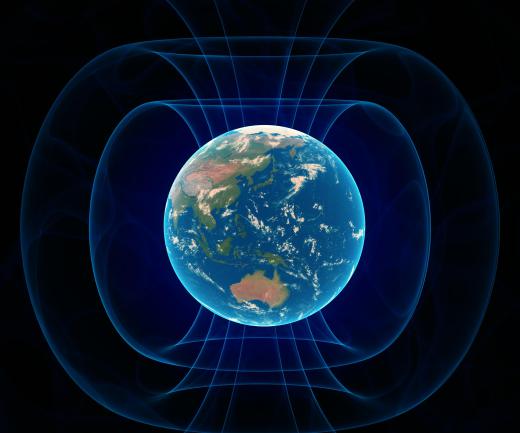What is the Structure of the Earth?
 Michael Anissimov
Michael Anissimov
The structure of the Earth is layered, and commonly divided into four parts: the silicate crust, the viscous mantle, the liquid iron-nickel outer core, and the solid iron-nickel inner core. Occasionally, the mantle is further subdivided into the inner and outer mantle, based on differences in rock type, temperature, density, and viscosity. The crust, which is the only part of the Earth that is both relatively cool and completely solid, makes up less than 1% of its total volume.
The first part of the structure of the Earth, the crust, consists of cooled rock floating on top of the viscous mantle. The thickness of the crust varies mainly depending on whether it is oceanic (5 km (3 mi) to 10 km (6 mi) thick) or continental (30 km (20 mi) to 50 km (30 mi) thick). The oceanic crust is composed of dense rocks such as gabbro, basalt, and diabase, while the continental crust is made up of somewhat lighter rocks such as granite. The deepest hole ever dug by humans into the crust is 11.26 km (7.62 mi), about a third of the way to the mantle.

Below the crust is the mantle, the shallowest part of which is made up of rocks like olivine, pyroxenes, spinel, and garnet, while the deeper parts are made of high-pressure polymorph minerals with similar elemental composition as the rock above. The mantle is a plastic solid which flows slowly over the course of millennia, creating convection currents similar to those seen when pasta is put into boiling water, just at a much slower speed. These convection currents can create volcanic hotspots and cause continental drift. The mantle is the thickest part of the structure of the Earth, about ~2,890 km thick (1,800 miles), and constituting 70% of the Earth's volume. Scientists have learned much about the mantle by studying the way that it effects seismic waves which pass through it.

The centermost parts of the structure of the Earth are the outer and inner mantle. The outer core is made of molten iron and nickel. At this depth, temperature is sufficient to melt iron and nickel, but pressure is not enough to force it to become solid. The outer core contains the vast majority of the planet's iron and nickel, which sank to the core when the Earth was in the process of forming about 4.6 billion years ago. Eddy currents in the outer core are believed to generate the Earth's magnetic field. The inner core has a similar makeup to the inner core, but the pressure there is sufficient to make it a solid. Temperatures in the inner core may exceed those on the surface of the Sun.
AS FEATURED ON:
AS FEATURED ON:














Discussion Comments
Though it comes as no surprise, the Earth is a place that has changed drastically over the years. No, not in terms of pollution, but in reference to the continents. Many places on the map have shifted dramatically, and even if you've learned this in school, it's still something interesting to think about. Who would have ever thought that so many continents would join as one?
It also makes me wonder if this is the same case with other planets, and how they were many years ago. Overall, we live in a universe that's constantly changing. An expansive world that's larger than we can begin to imagine, change might not always be a good idea, but on the other hand, it certainly adds to the uniqueness of our solar system.
Many years ago, people used to believe that the Earth was square shaped. It sounds like one of the most ridiculous theories, but back then, I feel that it made sense. Although I do wonder if they were able to view pictures of the Earth back then, with its round shape. If that's the case, then I wonder what led them to believe that it had a different shape. Fortunately though, this theory was debunked, and many people see the planet for how it truly is. Earth is a fascinating place, without a doubt. Filled with wildlife and machines alike, it's amazing to think that it's only one of the many "stars" in our solar system.
Post your comments